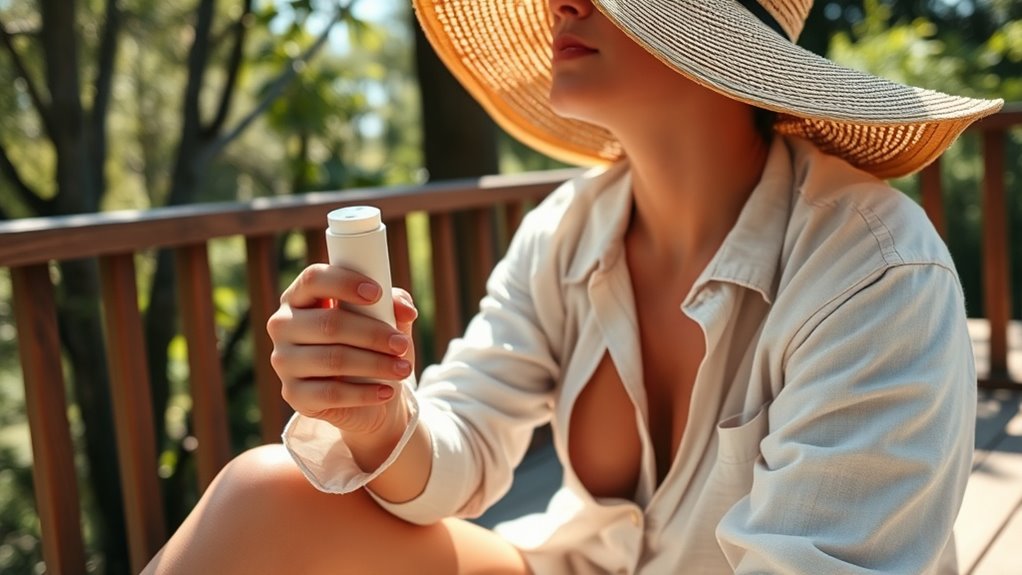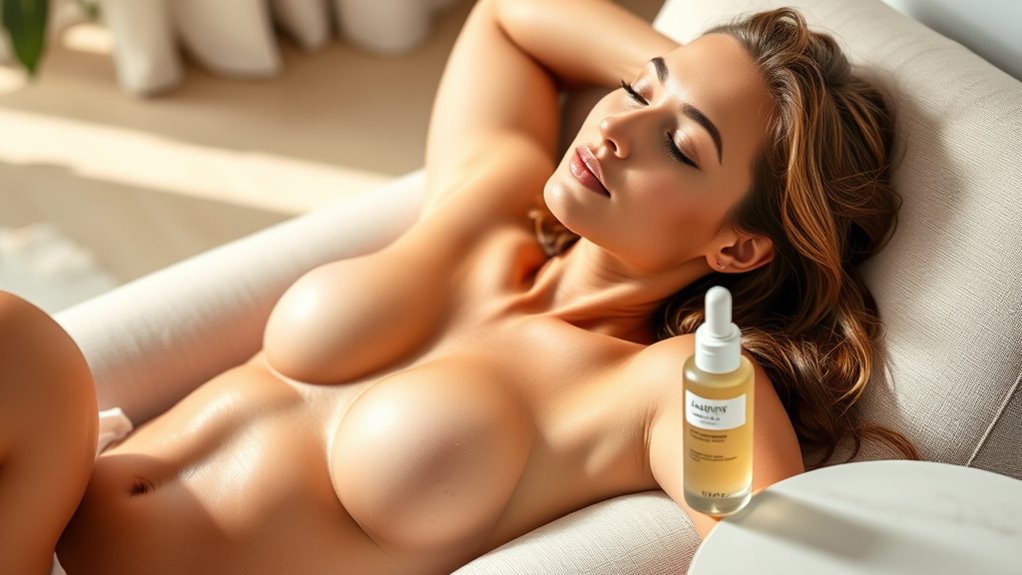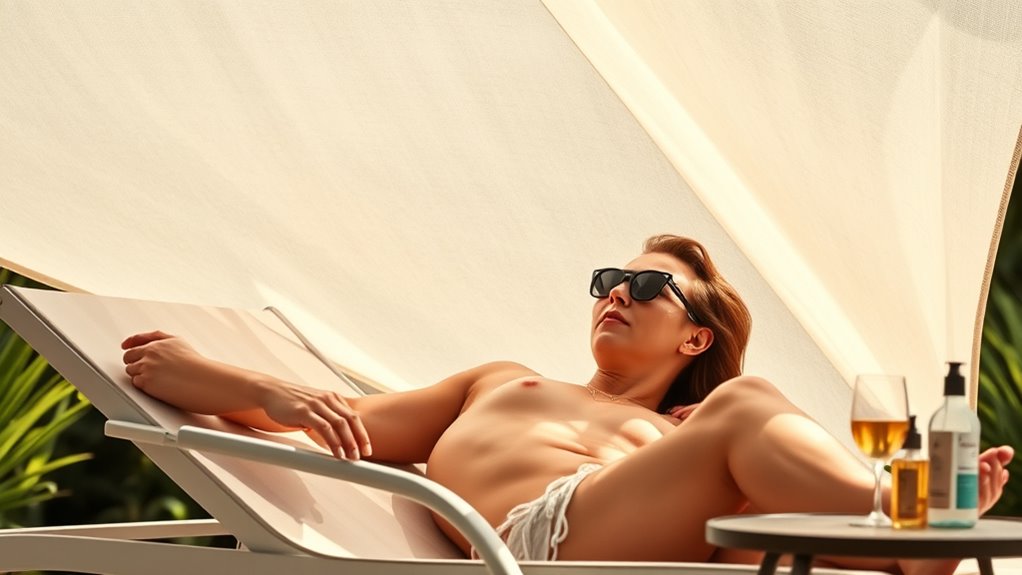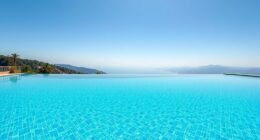To tan with minimal sun exposure, limit your outdoor time to early mornings or late afternoons, and wear protective clothing like hats and sunglasses. Use broad-spectrum SPF 30+ sunscreen on all exposed skin, reapplying regularly. You can also try sunless options like self-tanning lotions or sprays, which provide a natural-looking tan without UV risk. If you’d like to discover more safe tanning tips, there’s plenty of useful information to explore.
Key Takeaways
- Use sunless tanning products like self-tanners or spray tans for immediate, even color without UV exposure.
- Limit outdoor sun exposure to early morning or late afternoon, avoiding peak hours from 10 a.m. to 2 p.m.
- Wear protective gear such as hats, sunglasses, and UV-protective clothing when outdoors.
- Apply broad-spectrum SPF 30+ sunscreen on all exposed skin and reapply every two hours.
- Exfoliate and moisturize skin regularly to enhance and prolong the results of sunless tans.
Understanding the Risks of Excessive Sun Exposure

Excessive sun exposure poses significant health risks that you should be aware of. UV radiation penetrates your skin’s outer layers, causing direct DNA damage in skin cells. This damage triggers mutations that can disrupt cell function and lead to uncontrolled growth, increasing your risk of skin cancer. Repeated exposure adds up, raising the chances of malignant transformations over time. UV-induced oxidative stress worsens cellular damage, while impaired DNA repair mechanisms after too much sun make you more vulnerable to developing skin tumors. Skin cancer remains the most common cancer in the U.S., affecting people of all skin types. The more severe sunburns, especially during childhood, the higher your lifetime risk. Cumulative UV exposure accelerates aging, causing wrinkles, age spots, and loss of skin elasticity.
Safe Practices for Short, Controlled Sun Visits

To enjoy the benefits of tanning while minimizing health risks, it’s important to keep sun exposure brief and well-controlled. Limit your time outdoors to short sessions, ideally in the early morning or late afternoon when UV rays are less intense. Rotate your positions frequently to ensure even tanning and prevent burning. Watch for signs of redness or soreness, and seek shade immediately if your skin begins to pink or feels uncomfortable. Use broad-spectrum sunscreen with SPF 30 or higher on all exposed areas, including often-missed spots like ears and feet. Stay hydrated by drinking water regularly, and wear protective gear such as hats, sunglasses, and UV-protective clothing. Incorporating sun safety practices into your routine can further reduce the risk of skin damage. Additionally, understanding industry transformations, such as the importance of AI automation and innovative solutions, can help you stay informed about evolving safety technologies and products. Being aware of glycolic acid benefits and its role in skin health can also support your skincare routine, especially if you plan to incorporate exfoliating products post-sun exposure. Recognizing the importance of color accuracy in skin tone assessment can assist in monitoring your progress and ensuring a natural-looking tan. These practices help you achieve a tan safely without exposing your skin to unnecessary risks.
Exploring Sunless Tanning Options and Their Benefits

Sunless tanning options provide a safe and convenient way to achieve a bronzed look without exposure to harmful UV rays. You can choose from lotions, gels, mousses, or sprays, with dihydroxyacetone (DHA) as the main active ingredient, reacting with skin amino acids to create color. Combining DHA with erythrulose can enhance tan longevity and hue. Self-tanning mousses often give natural results and are easy to apply, while spray tans provide quick, even coverage but require careful handling. Benefits include avoiding UV damage, customizing tan intensity, and maintaining a year-round glow, including winter. Keep in mind that sunless tans are surface-level and fade within days. Proper exfoliation and moisturization ensure even, longer-lasting results, making sunless tanning a smart, safe alternative. Additionally, choosing the right application tools, such as a mitt or sponge, can help achieve a more professional-looking finish. Using a quality air purifier in your space can also help reduce airborne pollutants that might interfere with your skin’s health and recovery. Incorporating digital literacy into your skincare routine can help you better understand product ingredients and application techniques. Moreover, selecting products with appropriate ingredients can optimize results and reduce potential skin sensitivities. Being aware of FAQs about sunless tanning can also help you make informed choices and troubleshoot common issues.
Enhancing Tanning Results With Minimal UV Exposure

Maximizing your tan while minimizing UV exposure involves strategic planning and protective measures. Keep sun exposure during UV index levels of 3-5, which strike a balance between effective tanning and reduced skin damage. Avoid peak sun hours from 10 a.m. to 2 p.m. to limit harmful UV rays. Use protective gear like hats, sunglasses, and clothing made from tightly woven fabrics to shield your skin and eyes. Apply a broad-spectrum SPF 30 sunscreen regularly, reapplying every two hours or after water contact. Limit your sunbathing sessions to prevent overexposure. Remember, UVA light promotes melanin oxidation for tanning, while UVB causes burns; controlling exposure helps you achieve better results safely. Incorporating UV protection strategies can also support a healthier tanning routine. Combining these measures helps you get a darker tan without unnecessary risks.
Demographic and Behavioral Factors Affecting Sunburn Risk

Demographic and behavioral factors play a significant role in determining your risk of sunburn. If you’re under 40, you’re more likely to experience sunburns, especially during adolescence, which can increase melanoma risk later. Men tend to burn more often than women, partly due to behavioral differences like occupational exposure, while women usually use sunscreen more frequently. Racial and ethnic backgrounds also matter: non-Hispanic Whites face the highest risk, whereas Black individuals burn less but may undervalue sunscreen use. Socioeconomic status influences exposure, with higher-income groups experiencing more burns, often from recreational activities. Protective behaviors, such as sunscreen application and outdoor precautions, can reduce your risk, but skin sensitivity remains a key, unchangeable factor across all demographics. Additionally, skin type plays a crucial role in determining individual susceptibility to sun damage. Understanding cybersecurity vulnerabilities associated with personal data can further emphasize the importance of protective measures in daily life. Recognizing AI ethics in the context of personal health data collection highlights the need for privacy-conscious approaches to skin health monitoring. Furthermore, behavioral habits such as seeking shade and wearing protective clothing can significantly reduce exposure and risk. Studies also suggest that home environment factors, like the presence of shaded areas and reflective surfaces, influence sunburn likelihood.
Frequently Asked Questions
Can Certain Foods Naturally Boost Skin Tanning Without Sun Exposure?
You can naturally boost your skin’s tanning without much sun exposure by eating foods rich in beta-carotene, like carrots, spinach, and peaches, which stimulate melanin production. Incorporate lycopene-packed tomatoes and red fruits for added benefits. Include green vegetables, omega-3s, and collagen-boosting nutrients to improve skin elasticity and tone. These foods work together to enhance pigmentation and skin health, giving you a healthier, sun-kissed glow.
Are There Specific Skincare Routines to Prolong Sunless Tans?
Your skincare routine is like a shield for your tan, protecting it from fading. To prolong your sunless tan, keep your skin well-hydrated with moisturizer twice daily, especially on dry areas. Use gentle cleansers, avoid harsh exfoliants, and incorporate hydrating serums. Applying tan extenders and sunscreen daily helps maintain the color and prevent premature fading. Limit activities that cause friction or sweating, and always follow personalized skincare advice for best results.
How Do Age and Skin Type Influence Tanning Effectiveness?
Age and skin type play a big role in how effective your tanning efforts are. As you get older, your skin becomes less responsive to tanning, especially if you have sensitive or fair skin, which burns easily. Darker skin types naturally protect against UV damage, making tanning less noticeable. Your skin’s reaction depends on these factors, so understanding them helps you choose the right approach for a safer, more effective tan.
Is It Safe to Combine Natural Oils With Sunscreen for Tanning?
You might wonder if combining natural oils with sunscreen is safe for tanning. While natural oils can moisturize your skin and enhance your tan, they can also increase UV absorption, raising skin damage risks. Always opt for a high-SPF, broad-spectrum sunscreen and apply it generously. Don’t forget to reapply regularly and limit sun exposure during peak hours. This way, you protect your skin while enjoying the benefits of natural oils.
What Are the Best Methods to Avoid Streaks With Sunless Tanners?
Did you know uneven application causes up to 80% of streaks in sunless tanning? To avoid streaks, exfoliate thoroughly beforehand to create a smooth surface. Use a mitt or gloves for even application, working section by section. Apply moisturizer on dry areas, and dilute tanner on hands and feet. Post-application, wear loose clothes and stay dry for 4-5 hours to allow an even, natural-looking tan.
Conclusion
By choosing to tan with minimal sun exposure, you create a delicate dance between warmth and caution, like catching a fleeting golden sunset on the horizon. You protect your skin’s gentle glow while still embracing the sun’s subtle touch, savoring the feeling of warmth without the sting of burns. With mindful practices and sunless alternatives, you paint your skin with a sun-kissed hue, all while keeping your health safe and your confidence radiant.









